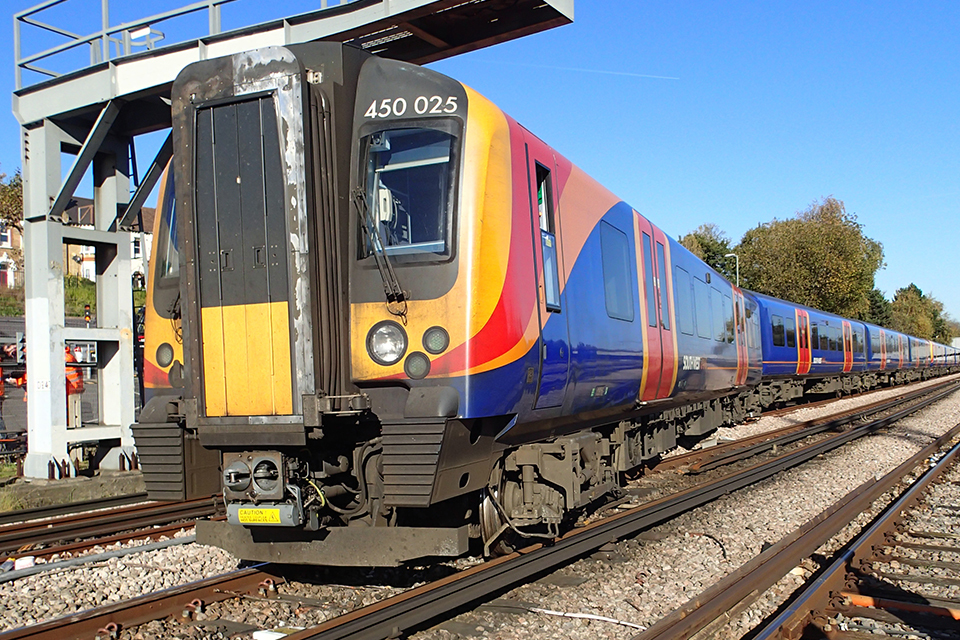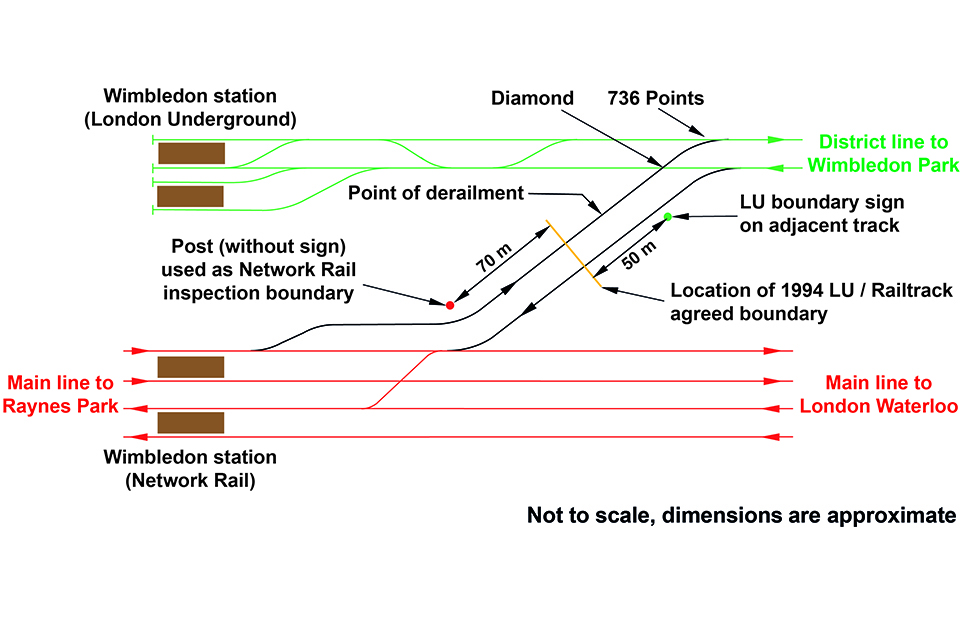Derailment of a passenger train near Wimbledon, south-west London, 6 November 2017
Published 7 February 2018
1. Important safety messages
This accident demonstrates the importance of:
- ensuring that the precise boundaries of maintenance responsibility, such as those between neighbouring infrastructure owners, are correctly documented and understood by staff and managers
- providing clear signage to mark maintenance boundaries so that inspection and maintenance staff from either side are sure they are working to the same boundary
2. Summary of the accident
At around 06:08 hrs, all wheels under the last carriage of the 04:54 hrs Basingstoke to London Waterloo train service derailed shortly after leaving Wimbledon station. The train, operated by South Western Railway, had travelled 348 metres after leaving the station and reached 19 mph (30 km/h) when the derailment occurred. The train continued in this derailed state for a further 185 metres causing significant damage to the track.
Although one set of doors in the rear carriage was opened by passengers using an emergency door release handle, all the passengers remained on board the train. Those in the rear carriage were moved forwards into other carriages until they were evacuated by the emergency services. The evacuation required around 300 passengers, including four with minor injuries, to walk a short distance along the track and use a specially constructed platform to bridge line side cabling. The evacuation was completed by 08:15 hrs.
Most Basingstoke to London services use the direct main line route. However some trains, such as this service, are timetabled to travel between Wimbledon and London Waterloo via Wimbledon Park. This route includes part of the District line which is owned and maintained by London Underground (LU). The derailment occurred on a short section of track that provides the link between the main line, which is owned and maintained by Network Rail, and the District line.

The rear of the derailed train
3. Cause of the accident
As the train traversed the link line, the left-hand wheels of the rear carriage dropped off the rail head and fell into the space between the two rails. This happened because the distance between the rails, known as the track gauge, was greater than the distance needed to restrain the wheelset. As the train continued, the right-hand wheels of the rear carriage were forced over the right-hand rail and dropped onto the ground. The rear carriage was dragged in this derailed condition through the District line junction. As the derailed wheels of the rear carriage passed through the junction, the front bogie remained in-line with the front of the train. The rear bogie followed the adjacent track causing the rear carriage to straddle both tracks and block the District line.
The distance between the rails was greater than the permitted maximum. The condition of the track suggested that it was poorly installed and that it had deteriorated over a period of many years including an increasing distance between the rails (gauge spread). This gradual deterioration of the track should be identified by track inspection and, if necessary, corrected by maintenance. Examination of the track following the derailment found that the track gauge was in excess of 1485 mm. The normal gauge for standard gauge track is 1435 mm, but it is acceptable for this to increase to 1460 mm before corrective work is required.
Both LU and Network Rail track is inspected by regular patrols that are conducted by staff looking for various faults including gauge spread. Where such faults are identified, they are reported so that corrective maintenance can be scheduled to take place. These patrols are specified in diagrams that show the route to be patrolled and, at locations where two infrastructure owners meet, the limit of each infrastructure owner’s maintenance responsibility. In addition to the patrol diagrams, it is common practice to identify the boundary by signage on, or adjacent to, the track.
London Underground has stated that the track maintenance boundary was set in 1994 as part of a demarcation agreement between LU and Railtrack, the mainline infrastructure owner before Network Rail. However, the track patrol diagrams provided to the LU and the Network Rail patrollers were found to stop short on both sides of this agreed boundary, leaving a gap between them.

Schematic diagram showing relative locations for the point of derailment, boundary markers and agreed boundary position
The LU diagrams state that patrollers are required to inspect the crossover and diamond associated with 736 points (figure 2). Those responsible for the LU patrol inspections also referred to an internal document titled ‘Inter Infraco Track Boundaries’ dated 5 May 2009. This document defined the boundary as ‘up to and including fishplates on NR [Network Rail] side of crossover leading from 736 points’. These limits approximately align with an LU maintenance boundary sign installed alongside an adjacent track which the LU patrollers stated they had been using as the patrol limit. This was around 50 metres short of the boundary agreed in 1994. The derailment occurred on LU infrastructure around halfway between this sign and the 1994 agreed boundary.
The diagrams provided to the Network Rail patrollers state the limit of inspections are at 8 miles 38.5 chains from London Waterloo via East Putney. This is approximately 40 metres along the link line and about 70 metres before the agreed boundary. The manager responsible for the Network Rail patrollers stated that a post near this location was used as the boundary marker. Historic photographs indicate that no sign indicating this, or any other information, had been attached to the post for many years.
Patrollers from LU and Network Rail are expected to look over at the track immediately beyond the boundary of the infrastructure for which they are responsible, and report faults found to the adjacent infrastructure owner. Patrollers cannot cross over the boundary at Wimbledon due to the differing personal track safety certifications required by each organisation. Whilst patrollers may have been checking the area immediately beyond their boundary, the gap of 120 metres between patrolled areas meant that there was a significant stretch of track that was missed from inspections.
Neither LU nor Network Rail have been able to provide reasons why the boundary was different in the patrol diagrams and why these did not match the location agreed between the two organisations in 1994. The consequence of this oversight was that the track was not being inspected or maintained for many years and so degraded into an unsafe condition.
You can print this safety digest.

